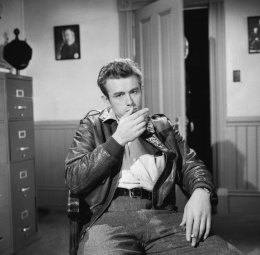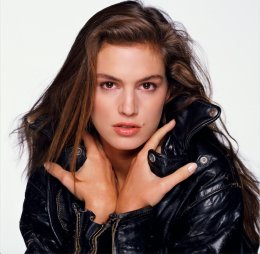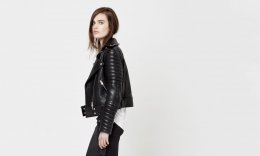Most popular Leather Jackets
 This was in the ‘90s, just before high-end leather jackets became ubiquitous. My friend referred to the jacket as a kind of armor – she went to a middle school she hated, but the jacket kept her safe. In it, she looked like the girl lead in the John Waters films we both loved, or like Winona Ryder on the cover of a magazine. I was impossibly jealous. I wanted desperately to find my own jacket like hers.
This was in the ‘90s, just before high-end leather jackets became ubiquitous. My friend referred to the jacket as a kind of armor – she went to a middle school she hated, but the jacket kept her safe. In it, she looked like the girl lead in the John Waters films we both loved, or like Winona Ryder on the cover of a magazine. I was impossibly jealous. I wanted desperately to find my own jacket like hers.
Almost exactly a year ago, as the season turned into back-to-school, I decided to make a significant investment in a piece of clothing for the first time. I have always been wary of spending money on clothes, seeking out second-hand items or passable inexpensive imitations. But I decided it was time to purchase a piece of clothing from which would emerge not an upgraded wardrobe, but an entire upgraded life.
Photo: Christian Vieri/Getty
If this is perhaps an absurd expectation to put on a single purchase, it is also often what we want from clothes, no less than complete transformation. We imagine an item will launch us out of our inescapable banality into a better, cooler, more interesting self. With clothes, as every makeover sequence in a movie promises, we can escape ourselves. I considered other options, but ultimately there wasn’t any choice. It had to be a leather jacket, because it was a leather jacket that would finally make me cool. It would offer me a fully formed new identity, pre-made and irrefutable.
It had to be a leather jacket, because it was a leather jacket that would finally make me cool. It would offer me a fully formed new identity, pre-made and irrefutable.
The leather jacket, in particular the biker jacket, is for many people this transformative item of clothing. Wearing a biker jacket promises that you get things done, that you’re not trying to impress anybody, even as the whole point of the jacket is look impressive. It promises action, moving beyond the restrictions of purely decorative clothing – the leather jacket carries in it the idea of escape and adventure, and promises to transform you into the kind of person capable of both. The jacket is a new, tougher, better skin.

Photo: CBS Photo Archive
The history of leather jackets progresses unavoidably along binary gender lines. Men’s jackets start from function – the "bomber jacket, " the immediate inspiration for the jackets worn by movie stars in iconic photos from the 1950s, was a military garment, designed to protect pilots from falling out of planes. A version of the same jacket was marketed to civilian men in the 1920s, when Schott jackets cost $5.50. In the 1950s, male movie stars and musicians appropriated the jackets from motorcyclists and pilots, and then women re-appropriated it from them in the decades that followed.
Leather jackets on women in the ‘60s and ‘70s are images of rebellion. The jacket meant either sleeping with the boys or wanting to be one of them. It was a means of refusing femininity, and in many instances a signal of female queerness. The women’s leather jacket enters the world of fashion in the 1960s and ‘70s, but it stays firmly in specific demographics, symbolizing a particular identity – a wealthy straight woman in these eras would never have worn a biker jacket. It wasn’t until the 1990s, when it became part of the personal uniform for supermodels that the jacket joined mainstream fashion. Designers started making versions of the biker jacket tailored specifically for women. It no longer necessarily looked like one had borrowed it from a boyfriend who owned a motorcycle, and it no longer visually represented a rejection of femininity.
It wasn’t until the 1990s, when it became part of the personal uniform for supermodels that the jacket joined mainstream fashion. Designers started making versions of the biker jacket tailored specifically for women. It no longer necessarily looked like one had borrowed it from a boyfriend who owned a motorcycle, and it no longer visually represented a rejection of femininity.
Photo: Terry O'Neill
Somewhere between Debbie Harry and Cindy Crawford, the leather jacket transforms into an accessible symbol of cool. Cool often indicates gentrification and gentrification’s inherent violence. Much of what becomes cool begins its life as part of the codes necessitated by oppression. Cool is then a translation of these codes into the mainstream – the swagger that comes with cheating death is often a very strong look. The 1990s in particular was a high tide of gentrification, a time when the country mined the underprivileged corners it had left in the dark for successful mainstream aesthetics. In this era of gentrification, the leather jacket moves from a symbol of alternative identity to a symbol of generalized cool.









